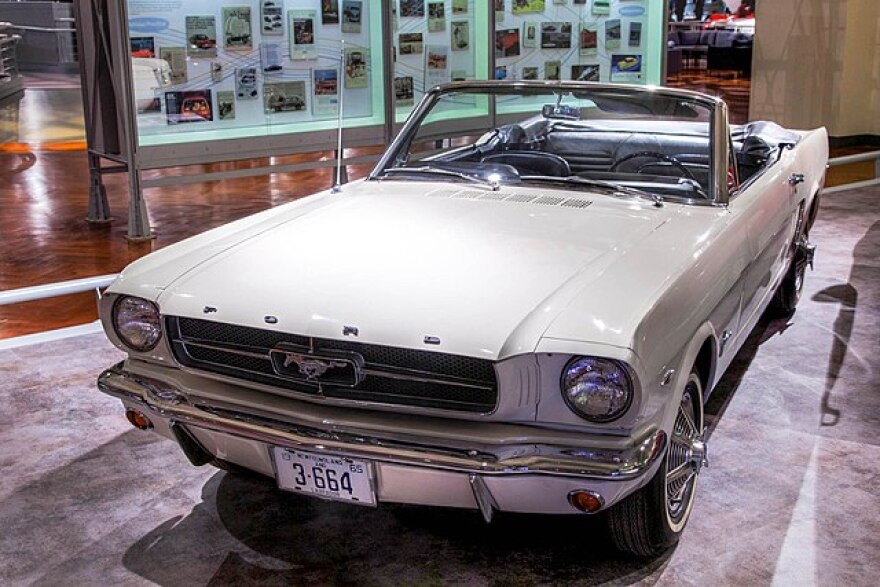Automotive legend Lee Iacocca, known best for developing the Ford Mustang and pulling Chrysler back from the brink of bankruptcy in the 1980s, has died. He was 94.
The son of Italian immigrants rose from a modest background to become a household name as CEO of Chrysler Corporation.
When Iacocca's father, Nicola, arrived at Ellis Island in 1902, a brand new American industry was grabbing headlines. Young men dreamed of owning a car — Nicola's son, Lee, dreamed of making them.
In 30 years, Iacocca worked his way up from an entry level engineering job to President of Ford.
The promotions were well deserved, says author Jason Vines, who worked at both Ford and Chrysler. Iacocca was smart and ambitious. He worked incredibly hard. And he inspired others to do the same.
"When Lee talked, people listened," Vines said.

One of Iacocca's greatest successes at Ford was the Mustang. Nothing like it existed at the time, but Vines says Iacocca had a sixth sense for what people wanted. Like an affordable four-seat sports car with pure American DNA.
"And of course the Mustang is as strong or stronger than it's every been," Vines said. "And that was his baby. He didn't design it but he's the one who pushed it through when he was at the head of Ford Motor Company."
But - then something happened to Iacocca's golden boy career. The something was Chairman Henry Ford the Second. Their once-cordial relationship soured, and in 1978, Iacocca was fired.
It didn't take long for Chrysler to snap him up as its CEO.
But that move took him out of the frying pan into the fire.
Months after taking the job, Chrysler was in the headlines, on the verge of bankruptcy.
Since banks wouldn't give Chrysler any more money, the government was Iacocca's only hope. He endured countless hours in the halls of Congress in Washington, D.C., sat in the hot seat in Congressional hearings. He got the money.
"And he saved the company, not single-handedly, he had a good team around him," Vines said. "But it was his force, his persuasive abilities with Congress, with creditors, that really let Chrysler get the loan guarantees and then, of course, famously he paid them back early with interest."
Vines says everyone knew who Lee Iacocca was after that. Chrysler's ad guys decided his straight to the point style was made for TV. The newly famous CEO would tell Americans why Chrysler was a better company, making better cars.
Chrysler began to make money again. Iacocca was not just well known, he was admired and beloved.
That's why President Ronald Reagan tapped Iacocca to lead private fundraising efforts of national importance.
Lady Liberty — and Ellis Island — had fallen into disrepair.
"The condition of the statue was not good," Stephen Briganti said. "It was deteriorating but it was not about to fall down. The condition of Ellis Island was terrible."
Briganti heads the Statue of Liberty–Ellis Island Foundation.
Briganti says once again, when Lee Iacocca talked, people listened. Money poured in. Big checks from corporations and foundations, but also ten, twenty dollar checks from ordinary Americans. Schoolkids collected quarters for the cause. The campaign raised $700 million, a huge sum at the time.
"His legacy will be the Statute of Liberty and Ellis Island more than it will be Chrysler," Briganti said. "The Statue of Liberty and Ellis Island, particularly the Statue of Liberty, will never go away. Chrysler may go away."
Iacocca retired from Chrysler in 1992. He gave a lot of speeches about the auto industry, his career, and his life.
He once told an audience he felt he had lived the American Dream.
Fiat Chrysler released the following statement:
The Company is saddened by the news of Lee Iacocca's passing. He played a historic role in steering Chrysler through crisis and making it a true competitive force. He was one of the great leaders of our company and the auto industry as a whole. He also played a profound and tireless role on the national stage as a business statesman and philanthropist. Lee gave us a mindset that still drives us today – one that is characterized by hard work, dedication and grit. We are committed to ensuring that Chrysler, now FCA, is such a company, an example of commitment and respect, known for excellence as well as for its contribution to society. His legacy is the resiliency and unshakeable faith in the future that live on in the men and women of FCA who strive every day to live up to the high standards he set.





